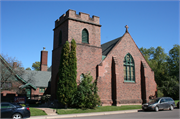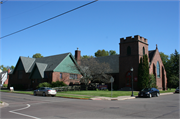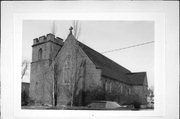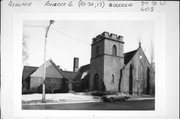Property Record
620 3RD ST W
Architecture and History Inventory
| Historic Name: | St. Andrew's Episcopal Church and Guild Hall |
|---|---|
| Other Name: | |
| Contributing: | |
| Reference Number: | 210 |
| Location (Address): | 620 3RD ST W |
|---|---|
| County: | Ashland |
| City: | Ashland |
| Township/Village: | |
| Unincorporated Community: | |
| Town: | |
| Range: | |
| Direction: | |
| Section: | |
| Quarter Section: | |
| Quarter/Quarter Section: |
| Year Built: | 1904 |
|---|---|
| Additions: | |
| Survey Date: | 19822016 |
| Historic Use: | church |
| Architectural Style: | Late Gothic Revival |
| Structural System: | |
| Wall Material: | Brick |
| Architect: | John Sutcliffe Chicago |
| Other Buildings On Site: | |
| Demolished?: | No |
| Demolished Date: |
| National/State Register Listing Name: | Not listed |
|---|---|
| National Register Listing Date: | |
| State Register Listing Date: |
| Additional Information: | POINTED ARCH WINDOWS SQUARE TOWER WINDOWS MAY BE BY TIFFANY ALTAR SCULPTURE BY H KRUSCKE (LOCAL) SUPERB HAMMER-BEAM ROOF 1982 DESCRIPTION: This large L-plan church structure consists of low widely gabled sections that create a picturesque roof line. The foundation is made of brownstone and above this, the brownish red brick walls are pierced by a number of pointed arch windows, many with Tiffany style stained glass. Facing northwest, the church's meeting room consists of a low and shingled front end gable that is intersected at right angle by another gabled projection. Large oak doors with metal strap hinges resemble closely the English Gothic Revival precedent. Inside this room, the ceiling has been lowered and only parts of the large oak ceiling beams are visible. A small kitchen is located toward the rear and two entries exist for this wing: one on West 3rd Street and another at the inside angle of the plan. This entire wing is subordinated to the nave and worship wing of the church that faces southwest. The large part of the church, this section is made of a broad gable with a tall stained glass pointed window at the Chapple Avenue end that is supported by a pair of brick Buttresses. The window has a wood tracery from Ashland's Scott-Taylor Company. At the northwest corner of the nave a squat square tower contains an entry and small pointed arch windows on the ground level. Above, a single pointed arch window is on each wall of the tower, which is capped by battlements and a narrow pent roof below. At the east end of the nave, the transept consists of a smaller gabled wing on the south and joins the meeting room on the north side. The interior of this church is an excellent example of turn-of-the-century English Gothic Revival church architecture. The most significant feature is the massive and finely detailed hammerbeam roof made of solid oak timbers by the Scott Taylor Company of Ashland. Secondly, the fine-quality stained glass, reportedly by Tiffany and Company, is intact throughout. Lastly, the alter fixtures are original and especially noteworthy is the Bible stand. It consists of a hand carved oak eagle on a brass stand. The carving was done by a highly skilled local craftsman, H. Kruschke, who stamped his name on this piece. SIGNIFICANCE: St. Andrew's episcopal Church of 1904 is architecturally significant as a local example of English Gothic Revival style church architecture of the finest quality. This simple red brick walls, the shingled gables, the subdued picturesque quality express handsomely the most important features of this style. The interior, especially the hammer-beam roof, is probably unsurpassed in quality of design and craftsmanship in northern Wisconsin. This congregation was first organized in Ashland in 1881 due to the efforts of missionaries. The first building was a frame structure with a tall central gable, pointed arch windows and a square corner tower designed in the stick style. This was built in 1886 and stood at the corner of 8th Avenue West and 3rd Street. 2017 survey report information: Rising from a brownstone foundation, this low-lying, English-inspired, Neo-Gothic Revival-style church includes an attached, English Arts and Crafts-inspired Guild Hall, both buildings of which are sheathed with brick. The church proper is located at the rear (south) of the lot and is oriented on an east-west axis. The two-story, crenelated bell tower includes a double-door entry along its north elevation, while pointed-arch, louvered openings are located along its upper level. The gabled endwall along Chapple Avenue includes a large focal window with tracery that has been identified as having been produced by the Scott-Taylor Company of Ashland. Brick buttressing vertically articulates the nave’s exterior and which alternate with pairs of Gothic-arched windows with stained glass. Also produced by the Scott-Taylor firm are the timbers employed within its impressive hammerbeam ceiling. The side-gabled Guild Hall is attached to the church via a short hallway near its east end. Additional entrances to the structure are located within gabled projections to the west and along 3rd Street West. Gabled peaks are covered with wooden shingles and windows are rectangular, stained-glass and/or colored examples. The ceiling of this building has since been lowered and the original ceiling beams are only partially visible. The first services of St. Andrew’s Episcopal Church were held in 1879; however, they would not construct a house of worship until 1886 (at the southeast corner of MacArthur Avenue and Third Street West). Outgrowing their earlier facility, they engaged Chicago architect John Sutcliffe to design their new edifice, which included a guild hall. It was completed in 1904 at a reported cost that exceeded $27,000. At that time, the congregation numbered 125 families. Local contractors Benjamin Harper and John H. Foster & Sons were both involved with the construction, while interior woodwork was supplied by the Scott-Taylor Co. In addition, the church contains a hand-carved lectern made by one of Ashland’s early cabinetmakers, Herman Krushke, which was moved from their earlier church building. The church’s stained-glass windows have been cited as designs of Tiffany & Company, however, that has not been fact-checked for this report. By 1911, the congregation numbered just fifty-five families and, as of 1925, that number was recorded as including 135 communicants. The church continues to serve Ashland’s Episcopalian community. Architect John Sutcliffe was born in 1853 in Lancashire County, England. Sutcliffe was the son of a contractor, who went on to become an architect and engineer. Sutcliffe started working in his father’s office at the age of eleven and, in the evenings, went to night school where he took classes in science and art. After leaving his father’s employ, but while still in England, he went on to work for a number of architectural and engineering firms. He then served as chief draftsman in the British government’s Portsmouth dockyard. Sutcliffe immigrated to the United States in 1886, at the age of thirty-three. He worked in New York, Boston, and Birmingham, Alabama (where he founded the Alabama Association of Architects), before he moved in 1892 to Chicago where he specialized in ecclesiastical architecture. He was noted as steeped in the English tradition of Gothic architecture, but he was also able to provide some degree of originality to his work—which put him in a class along with Ralph Adams Cram with regard to church architecture. Sutcliffe’s 1913 obituary identifies him as a devout Episcopalian. Among Sutcliffe’s more notable church work in Illinois include the following: The Cathedral Church of St. Paul the Apostle (1913) in Springfield, St. Luke’s Episcopal Church (1906) in Evanston and his own congregation, Grace Episcopal Church (1905) in Oak Park. This is the only known/recorded church design of Sutcliffe’s in Wisconsin; however, he would later design the 1911 Frances Donaldson Library on the National Register-listed, Nashotah House Seminary Campus in Waukesha County. |
|---|---|
| Bibliographic References: | "Fine church edifice Episcopal Church Completed." Asland Daily News, 3 December 1904. Citations for 2017 information below: “Fine Church Edifice, Episcopal Church Completed,” The Ashland Daily Press, 3 December 1904; Entry for Benjamin Harper, Commemorative Biographical Record of the Upper Lake Region (1905), 325; Scott-Taylor, Kruschke and Tiffany references included in the 1983 survey report by Sennott and Tolliver; Manthei, “Ashland: Oh How You’ve Changed,” Vol. 2, page 5; A. Parker Curtiss, History of the Diocese of Fond du Lac and Its Several Congregations (Fond du Lac, WI: P.B. Haber Printing Co., 1925), Available online at http://anglicanhistory.org/usa/wi/fonddulac1925/parishes.html, Accessed June 2017. “Obituary of the Late John Sutcliffe,” Construction News (Chicago, IL), vol. 36, 8 November 1913, 11 (includes photo). |
| Wisconsin Architecture and History Inventory, State Historic Preservation Office, Wisconsin Historical Society, Madison, Wisconsin |




